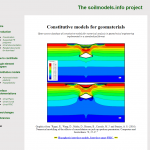SoilModels has been established as “soilmodels.info project” during September 2007 meeting of ALERT association in Aussois, France, by a group of internationally recognized researchers in the field of constitutive modelling in geomechanics by the following Letter to the Editor of the International Journal for Numerical and Analytical Methods in Geomechanics:
These researchers recognized that, although significant progress in the field of soil material modelling in the last 50 years, there are difficulties in propagating advanced models into daily geotechnical practice. In fact, most widely used constitutive model (Mohr-Coulomb) has been established back in 1901 and even Modified Cam-clay model (developed in 1968) is often considered as an advanced model in numerical simulations in practice. They felt that the way to escape from this predicament was to generate a freely available database of constitutive models, which enabled any researcher or potential user to choose the models that appear suitable for solving the problem with which they are confronted and to compare the capabilities of these models without having to expend any effort in their implementation. A website has been created along with the project announcement, looking like this:
In 2017, after ten years of soilmodels.info existence, SoilModels website has been completely redesigned and its mission broadened. SoilModels is now a platform aimed at promoting the use of advanced geotechnical modelling techniques in daily geotechnical practice. It provides, free of charge, tools supporting modelling workflow of geotechnical engineer, starting with selection of appropriate material model, its parameter determination (including fully automatic calibration tool), providing model plugins for various finite element packages, providing datasets for model calibration and providing a platform to discuss potential issues with other members of SoilModels community. SoilModels provides the following main functionalities to support geotechnical modelling workflow:
Once the account has fully been activated by completing Members Profile, SoilModels members can download software and publications, use online software tools and publish posts into online Forum, further edit their own posts and comments, add new publications, maintain database items and downloads associated with their account and list download history of their files. New database items (like constitutive models, software tools and software downloads) need to be added by SoilModels Editors to ensure website consistency. Once database items have been created, however, they are further maintained by SoilModels contributors themselves.



Recent Comments